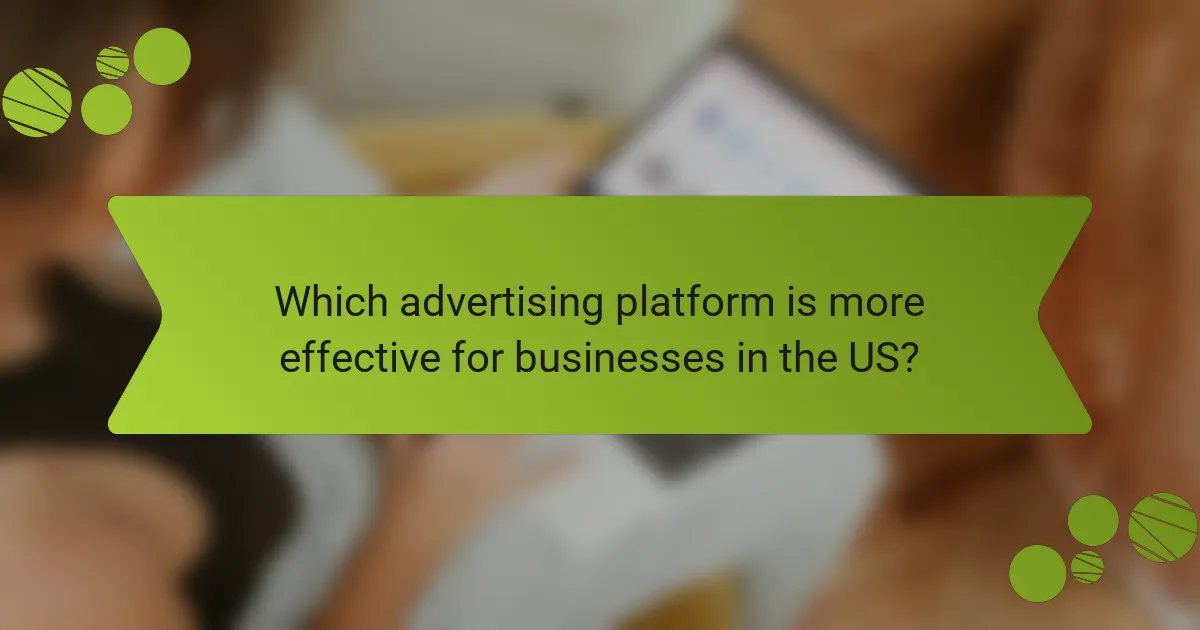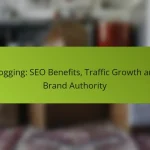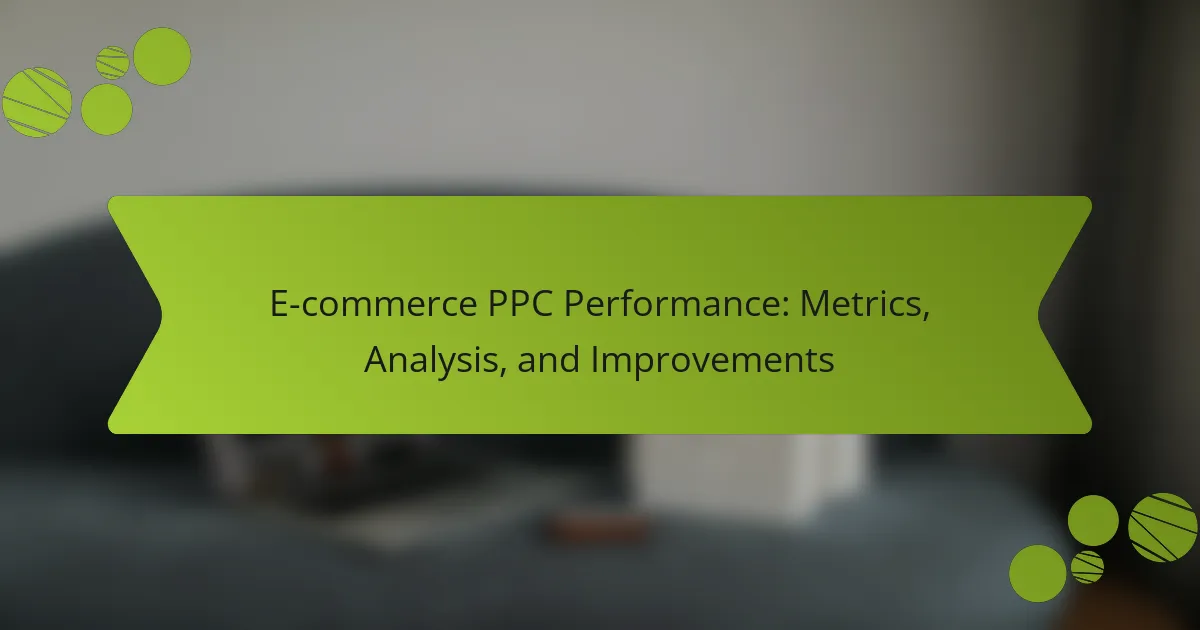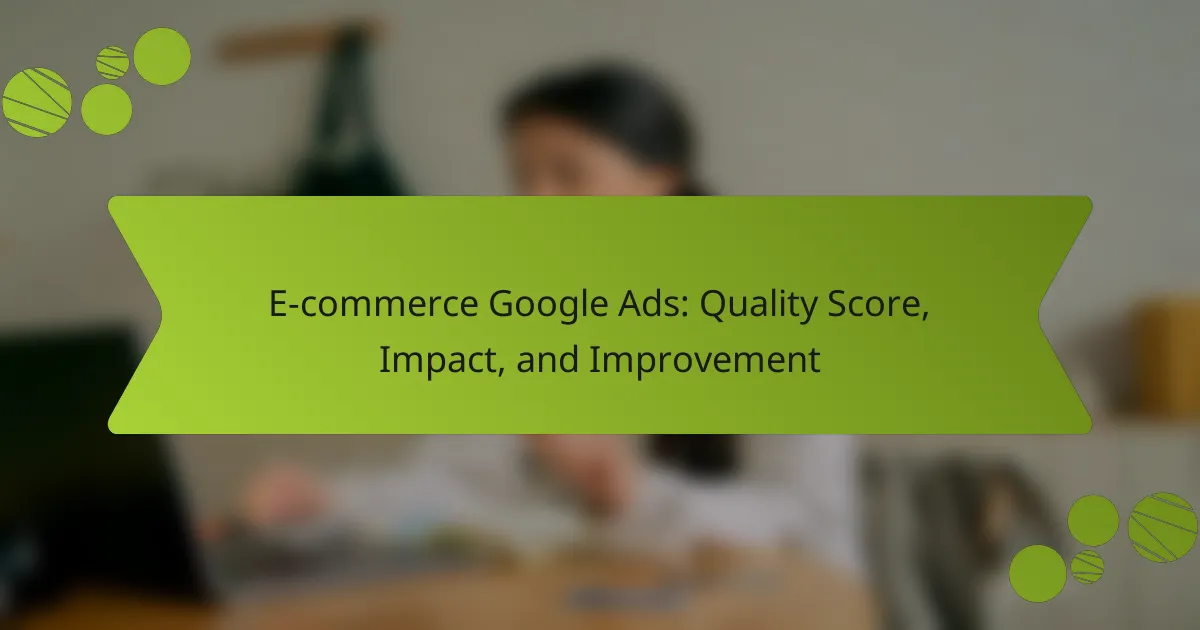When deciding between Google Ads and Facebook Ads, it’s essential to consider your marketing objectives and target audience. Google Ads is particularly effective for capturing high-intent customers actively searching for products or services, while Facebook Ads excels in building brand awareness and engaging a broader audience. Understanding the strengths of each platform can help you make informed decisions for your advertising strategy.

Which advertising platform is more effective for businesses in the US?
Google Ads is often considered more effective for businesses in the US when targeting high-intent customers, while Facebook Ads excels in fostering engagement with a broader audience. The choice between the two largely depends on your specific marketing goals and target demographics.
Google Ads offers high intent targeting
Google Ads allows businesses to target users actively searching for specific products or services, making it ideal for high intent targeting. When users enter relevant keywords, your ads appear, capturing potential customers at the moment they express interest.
This platform is particularly effective for businesses looking to drive immediate sales or conversions. For example, a local plumbing service can target keywords like “emergency plumber near me,” ensuring their ads reach users who need urgent assistance.
Facebook Ads excels in audience engagement
Facebook Ads focuses on engaging users based on their interests, behaviors, and demographics rather than immediate intent. This platform is effective for building brand awareness and nurturing relationships with potential customers over time.
For instance, a fitness brand can create visually appealing ads targeting users interested in health and wellness, even if they aren’t currently looking to make a purchase. This approach can lead to increased brand loyalty and customer retention.
Google Ads leads in conversion rates
Google Ads typically achieves higher conversion rates compared to Facebook Ads due to its focus on users actively searching for solutions. When users click on a Google ad, they are often further along in the buying process, which can lead to quicker sales.
Businesses can expect conversion rates to vary, but many see figures in the low single-digit percentages for Facebook Ads, while Google Ads can achieve rates in the mid to high single digits. This makes Google Ads a strong choice for direct response campaigns.
Facebook Ads provides detailed demographic insights
Facebook Ads offers extensive demographic insights, allowing businesses to tailor their advertising strategies effectively. Advertisers can access data on age, gender, location, and interests, enabling precise targeting to reach the right audience.
This level of detail helps businesses refine their campaigns and optimize ad spend. For example, a fashion retailer can target ads specifically to women aged 18-35 in urban areas, increasing the likelihood of engagement and conversions.

When should I use Google Ads?
Google Ads is best utilized when you need to drive immediate sales or leads, particularly through search intent. It allows businesses to target users actively searching for specific products or services, making it a powerful tool for conversion-focused campaigns.
For immediate sales and lead generation
Google Ads excels in generating quick sales and leads due to its pay-per-click model. When users search for relevant keywords, your ads can appear at the top of the search results, capturing attention right when they are ready to purchase.
To maximize effectiveness, focus on high-intent keywords that indicate a readiness to buy. For example, terms like “buy shoes online” or “best local plumber” can lead to immediate conversions.
When targeting specific keywords
Using Google Ads allows you to target specific keywords that are relevant to your business. This targeted approach ensures that your ads reach users actively searching for what you offer, increasing the likelihood of engagement.
Consider conducting keyword research to identify terms with high search volume and low competition. Tools like Google Keyword Planner can help you find the right keywords to bid on, optimizing your ad spend.
For local businesses aiming for foot traffic
Google Ads is particularly beneficial for local businesses looking to increase foot traffic. By utilizing location targeting, you can ensure your ads reach potential customers in your vicinity, encouraging them to visit your physical store.
Incorporate location-specific keywords and use ad extensions to highlight your address, phone number, and customer reviews. This strategy can significantly enhance your visibility to local consumers searching for services nearby.

When should I use Facebook Ads?
Facebook Ads are ideal when you want to build brand awareness, engage with specific audiences, or retarget users who have previously interacted with your website. Their extensive targeting options and community-oriented features make them a powerful tool for many businesses.
For brand awareness and community building
Facebook Ads excel in creating brand awareness and fostering community engagement. The platform’s visual nature allows businesses to showcase their products and services through eye-catching images and videos, which can capture attention effectively.
Utilize Facebook’s ad formats, such as carousel ads or video ads, to tell your brand story. This approach not only increases visibility but also encourages users to interact with your content, helping to build a loyal community around your brand.
When targeting specific demographics and interests
Facebook’s robust targeting capabilities enable advertisers to reach specific demographics and interests effectively. You can target users based on age, gender, location, interests, and even behaviors, allowing for a tailored advertising approach.
For instance, if you are selling eco-friendly products, you can target users who have shown interest in sustainability. This precision increases the likelihood of engagement and conversion, making your ad spend more efficient.
For retargeting previous website visitors
Retargeting on Facebook is a powerful strategy for re-engaging users who have previously visited your website. By using the Facebook Pixel, you can track visitors and display ads specifically to them, reminding them of products they viewed or left in their cart.
This method can significantly boost conversion rates, as retargeted users are often more likely to complete a purchase. Ensure your ads are compelling and include a clear call to action to maximize effectiveness.

What are the key differences between Google Ads and Facebook Ads?
Google Ads and Facebook Ads serve different purposes and target audiences in unique ways. Google Ads focuses on capturing intent through search queries, while Facebook Ads leverages user interests and behaviors to deliver ads.
Google Ads targets intent-based searches
Google Ads is designed to reach users actively searching for specific products or services, making it effective for capturing high-intent traffic. When someone types a query into Google, they are often looking to make a purchase or find information, which means they are further along in the buying process.
For example, a user searching for “best running shoes” is likely ready to buy. Advertisers can bid on relevant keywords to ensure their ads appear at the top of search results, increasing visibility and potential conversions. This approach often leads to higher click-through rates and better return on investment.
Facebook Ads focuses on user interests and behaviors
In contrast, Facebook Ads targets users based on their interests, demographics, and online behaviors rather than direct search intent. This allows businesses to create highly tailored ads that resonate with specific audience segments, even if those users are not actively looking to purchase.
For instance, a fitness brand can target ads to individuals who have shown interest in health and wellness pages. This method can be particularly effective for brand awareness and engagement, as it introduces products to potential customers who may not yet be aware of their needs.
Cost structures differ significantly
The cost structures of Google Ads and Facebook Ads vary, impacting how businesses allocate their advertising budgets. Google Ads typically operates on a pay-per-click (PPC) model, where advertisers pay each time someone clicks on their ad. This can lead to higher costs, especially in competitive industries.
On the other hand, Facebook Ads often use a cost-per-impression (CPM) model, where advertisers pay for ad views rather than clicks. This can make Facebook Ads more cost-effective for campaigns focused on brand visibility rather than immediate conversions. Businesses should evaluate their goals and budget to determine which platform aligns better with their advertising strategy.

How do I choose between Google Ads and Facebook Ads?
Choosing between Google Ads and Facebook Ads depends on your specific marketing goals and the behavior of your target audience. Each platform has unique strengths that can align with different objectives, so understanding your needs is crucial.
Assess your marketing goals and objectives
Start by clearly defining what you want to achieve. Google Ads is often better for direct response campaigns, such as driving immediate sales or leads, while Facebook Ads excels in brand awareness and engagement. If your goal is to reach customers actively searching for products, Google may be the right choice.
Conversely, if you aim to build a community or engage users with compelling content, Facebook’s visual and interactive formats can be more effective. Consider your objectives carefully to align them with the strengths of each platform.
Evaluate your target audience’s online behavior
Understanding where your audience spends their time online is key to choosing the right platform. Google Ads targets users based on search intent, making it ideal for reaching potential customers at the moment they are looking for solutions. Facebook Ads, on the other hand, allows for demographic and interest-based targeting, which is useful for reaching users who may not be actively searching but are likely to be interested in your offerings.
Conduct research or use analytics tools to gauge your audience’s preferences. If they frequently engage with social media, Facebook might be more effective, whereas Google could be better if they often use search engines to find products.
Consider your budget and expected ROI
Your budget will significantly influence your choice between Google Ads and Facebook Ads. Google Ads typically operates on a pay-per-click model, which can lead to higher costs per click, especially in competitive industries. Facebook Ads generally offer more flexible pricing options, including cost-per-impression and cost-per-click, which can be more budget-friendly.
Calculate your expected return on investment (ROI) for each platform based on your goals. If you have a limited budget, start with a smaller campaign on both platforms to test performance. Monitor results closely to determine which platform delivers better ROI for your specific objectives.

What are the prerequisites for using Google Ads and Facebook Ads?
To effectively use Google Ads and Facebook Ads, businesses need to establish clear advertising goals, have a defined target audience, and possess a budget for ad spend. Additionally, having a website or landing page is crucial for Google Ads, while Facebook Ads require a Facebook business page.
Setting up business accounts on both platforms
Setting up accounts on Google Ads and Facebook Ads involves distinct processes. For Google Ads, you need a Google account, which can be created for free. Once logged in, you can navigate to the Google Ads homepage and follow the prompts to set up your advertising account.
On Facebook, you must create a Facebook business page if you don’t already have one. After that, you can access Facebook Ads Manager through your page. This platform allows you to manage your ads, track performance, and adjust your campaigns effectively.
Both platforms offer user-friendly interfaces, but it’s essential to familiarize yourself with their unique features. For instance, Google Ads focuses on keyword targeting, while Facebook Ads emphasizes audience demographics and interests. Understanding these differences can help you optimize your advertising strategy.








